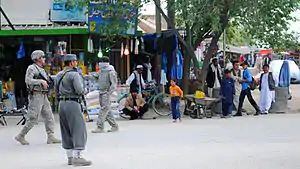Charikar
Charikar (Persian: چاریکار, pronounced Chârikâr) is the main town of the Koh Daman Valley and the capital of Parwan Province in northern Afghanistan. It has a population of around 171,200,[3] which is a multi-ethnic society.[4][5]
Charikar
چاریکار | |
|---|---|
 A street in Charikar | |
 Charikar Location in Afghanistan | |
| Coordinates: 35°0′47″N 69°10′8″E | |
| Country | |
| Province | Parwan Province |
| District | Charikar |
| Elevation | 1,600 m (5,200 ft) |
| Population (2015) | |
| • City | 96,093 [1] |
| • Urban | 96,039 [2] |
| Time zone | UTC+4:30 |
The city lies on the Afghan Ring Road, 69 km from Kabul along the route to the northern provinces. Travelers would pass Charikar when traveling to Mazar-i-Sharif, Kunduz or Puli Khumri. Despite the proximity to Kabul, slightly more than half of the land is not built-up. Of the built-up land almost equal parts is residential (37%) as vacant plots (32%) with a grid network of road coverage amounting to 19% of built-up land area.[6] Charikar is at the gateway to the Panjshir Valley, where the Shamali plains meet the foothills of the Hindu Kush. Charikar is known for its pottery and high-quality grapes.
The city of Charikar has a total population of 96,039 (2015) and has 4 Police districts (Nahias) with 3,025 Hectare of total land area.[6] There are 10,671 total number of dwellings in Charikar.[6]
History
In 1221, the Battle of Parvan was fought near Charikar, in which Jalal ud-Din with an army of 30,000 with 100,000 auxiliaries defeated a column of 30,000 men of the invading Mongol army to give part of his army enough time to escape into the northern Punjab, and avoid the immediate consequences of the fall of the Khwarezmid Empire.[7][8]
At the beginning of the 19th century, Charikar became a flourishing commercial town of several thousand inhabitants.[9] Charikar was the location of major battle during the First Anglo-Afghan War. In 1841 a British garrison was massacred.[10] In 1842 the British Army returned to lay waste to the town in their campaign of retribution.
During the Soviet–Afghan War, the region around Charikar was the scene to some of the fiercest fighting.[11] Some areas around Charikar served as a stronghold of the Liberation Organization of the People of Afghanistan (SAMA). Charikar was at the frontline between Ahmad Shah Massoud's Northern Alliance and the Taliban who captured Kabul in 1996. In January 1997 the Taliban took control of Charikar, but Massoud fought back and recaptured it by July.[12] In August 1999 the Taliban launched an offensive and briefly captured Charikar, before Massoud counterattacked and drove them out again.[13]
On August 14, 2011, a team of about six suicide bombers attacked the governor's palace in Charikar. The Governor Abdul Basir Salangi survived but 19 people were killed to which the Taliban claimed responsibility.[14]
On 19 May 2020, gunmen opened fire inside a mosque in Charikar, killing 11 worshippers and injuring 16 others when they were offering the evening prayer after breaking their Ramadan fast. The Taliban denied their involvement in the attack.[15][16][17]
On 26 August, 2020, the city was the site of floods that killed at least 92 people.[18]
See also
References
- "The State of Afghan Cities Report 2015". Archived from the original on 31 October 2015. Retrieved 21 October 2015.
- "The State of Afghan Cities Report 2015". Archived from the original on 31 October 2015. Retrieved 21 October 2015.
- "Settled Population of Parwan province by Civil Division, Urban, Rural and Sex-2012-13" (PDF). Islamic Republic of Afghanistan, Central Statistics Organization. Retrieved 2013-06-16.
- "Parwan Province". Program for Culture & Conflict Studies. Naval Postgraduate School. Retrieved 2013-06-16.
The population of approximately 560,000 is composed of Pashtun, Tajik, Uzbek, Qizilbash, Kuchi, Hazara, and other minority groups.
- "Regional Command East: Parwan Province". Institute for the Study of War. Retrieved 2013-06-16.
The main ethnic groups are Pashtuns and Tajiks, but there are small numbers of Uzbeks, Qizilbash and Hazaras as well.
- "The State of Afghan Cities Report 2015". Archived from the original on 31 October 2015. Retrieved 20 October 2015.
- Man, John (2005) Genghis Khan: Life, Death, and Resurrection St.Martin's Press, New York, pages 181–182, ISBN 978-0-312-31444-6
- Tucker, Spencer C. (2009). A Global Chronology of Conflict: From the Ancient World to the Modern Middle East, Volume I ca. 3000 BCE–1499 CE. Santa Barbara, California: ABC-CLIO. p. 273. ISBN 978-1-85109-667-1.
- Balland, Daniel. "ČĀRĪKĀR". Encyclopædia Iranica (Online ed.). United States: Columbia University.
- by Afghans led by Mir Masjidi Khan, and Major Eldred Pottinger was badly wounded Weber, George (2001-01-14). "Pioneer Biographies of the British Period to 1947". Archived from the original on 2007-12-13. Retrieved 2007-12-19.
- "Charikar". The Columbia Encyclopedia (Sixth ed.). Columbia University Press. 2007. Retrieved 2007-12-19.
- U.S. Conflicts in the 21st Century [3 volumes]: Afghanistan War, Iraq War, and the War on Terror by Spencer C. Tucker
- Al-Qaida in Afghanistan by Anne Stenersen
- "19 dead in attack on Afghan governor's compound".
- "Khalilzad In Kabul For Peace Talks Amid New Deadly Attacks". May 20, 2020 – via www.gandhara.rferl.org/.
- "Afghanistan: 9 killed after gunmen storm at Parwan mosque". May 19, 2020 – via www.indiatvnews.com/.
- "Gunmen attack Afghanistan mosque killing many worshippers". May 19, 2020 – via www.aljazeera.com/.
- Gibbons-Neff, Thomas; Abed, Fahim (2020-08-27). "'I Lost Everyone': Floods Bruise a War-Weary Afghanistan". The New York Times. ISSN 0362-4331. Retrieved 2020-08-27.
External links
| Wikimedia Commons has media related to Charikar. |